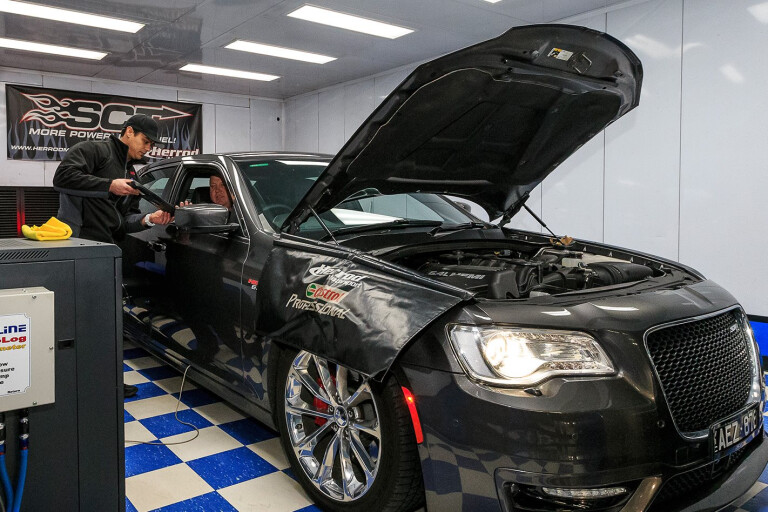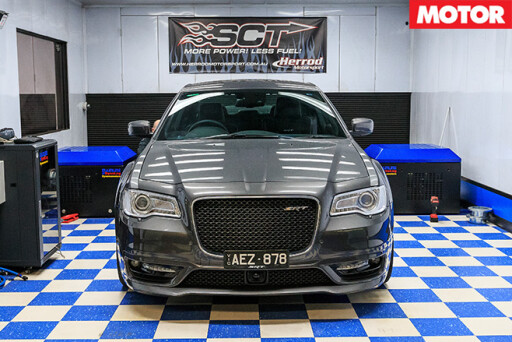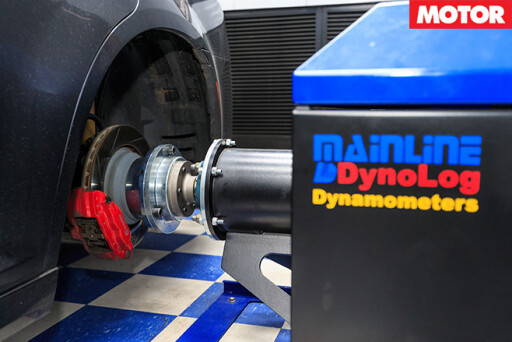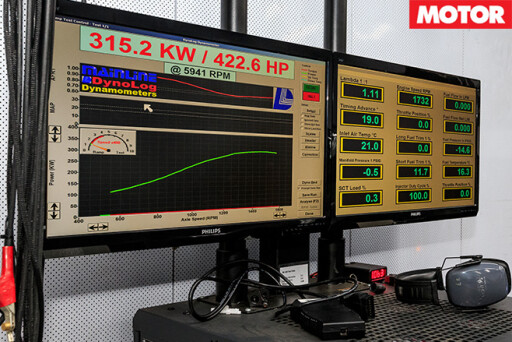
Big silver owes me an explanation. Last issue we hit the drag strip to see what she’d crack, only to be severely let down.
Back in January, MOTOR extracted a 4.49sec sprint to 100km/h and 12.6sec quarter mile from a different 300 SRT. Last month, however, big silver could only manage 5.3sec and 13.39sec.
Admittedly conditions weren’t perfect. Calder’s strip was cold, we only had two runs and I thought experimenting with its launch control rpm would’ve further helped. But even so, eight tenths is a light-year in motorsport.
 With that in mind, attention turned from one bragging right to another. Was our SRT’s 6.4-litre V8 all the Hemi gods intended it to be? There was one way to find out: a dynamometer. Before we get there, though, it’s important to know what we’re looking for.
With that in mind, attention turned from one bragging right to another. Was our SRT’s 6.4-litre V8 all the Hemi gods intended it to be? There was one way to find out: a dynamometer. Before we get there, though, it’s important to know what we’re looking for.
Against current technology, the Chrysler’s V8 is relatively crude. Firstly, it’s a big unit. After copping wider bore and longer stroke in 2012, it’s now the second largest atmo engine on sale. Only Lamborghini’s 6.5-litre V12 trumps it on capacity.
This hurts it dramatically at the bowser. Sure, it’ll knock off four cylinders while coasting and eight-cogs keep it on the boil, but every 100 clicks it’ll still need a polar bear-sinking 14-litre drink.
 It claws back the cred when it comes to power. With a 10:9.1 compression ratio the engine ignites 350kW of energy and 637Nm of twist within its hemispherical-domed cylinders. Well, that’s what the box is supposed to do. This is why we dragged big silver to Thomastown, out near Melbourne airport, to meet Rob Herrod. Owner of Herrod Motorsport, we managed to twist Rob’s arm into lending us his Mainline dyno for half an hour.
It claws back the cred when it comes to power. With a 10:9.1 compression ratio the engine ignites 350kW of energy and 637Nm of twist within its hemispherical-domed cylinders. Well, that’s what the box is supposed to do. This is why we dragged big silver to Thomastown, out near Melbourne airport, to meet Rob Herrod. Owner of Herrod Motorsport, we managed to twist Rob’s arm into lending us his Mainline dyno for half an hour.
The last time we strapped a Commodore SS-V Redline to a dyno 75kW evaporated between its engine crank and the Mainline rollers. Okay, different day, different car, and it had a manual transmission, but it gave me a ballpark for the SRT. On the same 98RON, anywhere around 275kW means AEZ 878’s packing all it should.
When I saw Herrod’s chassis dynamometer, though, that hypothesis went down the gurgler. Before me was a hub dyno, which does without rollers completely. Instead, it bolts directly to the car’s axles. Great for consistency, without roller-to-tyre contact, there are two less variables at play. But less so for my guestimate.
 Hooked to the Mainline hub packs, the SRT filled the fan-exhausted room with its roar. It pulled 315.2kW, 314.3kW, and then 315.3kW, undeniable repeatability, something Herrod praises the system for ever since he installed it, and importantly, very close to the car’s quoted figures.
Hooked to the Mainline hub packs, the SRT filled the fan-exhausted room with its roar. It pulled 315.2kW, 314.3kW, and then 315.3kW, undeniable repeatability, something Herrod praises the system for ever since he installed it, and importantly, very close to the car’s quoted figures.
But where did that leave me with my 75kW-loss guess? I was given Todd Lewis’s, Mainline Tech Director, number for more information. “The inertia of the wheels and tyres on rear most modern cars is in the range of 30-40hp (22kW to 30kW), at the average rate of acceleration that’s used on a roller dyno,” Lewis said. So really, a rolling road would sap another 30kW – totalling the difference at around 65kW.
 Okay, while hardly a definitive verdict, I wasn’t far off, and more importantly neither is our Chrysler 300 SRT, proving healthy as it should. Don’t agree? Herrod offers blowers for 2015-on SRTs that’ll take outputs to 440kW at the hubs. Crazy.
Okay, while hardly a definitive verdict, I wasn’t far off, and more importantly neither is our Chrysler 300 SRT, proving healthy as it should. Don’t agree? Herrod offers blowers for 2015-on SRTs that’ll take outputs to 440kW at the hubs. Crazy.
What about those eight tenths? That blower would easily take care of them. But as for our own AEZ 878, that will remain stock, well, maybe me and my drag testing skills are what owe an explanation.
MONTH FOUR
LIKED:
DISLIKED:
FAVOURITE MOMENT: Hearing our big bertha spin up the hubs is symphonic for petrolheads
FUEL THIS MONTH: 16.8L/100km
AVERAGE: 15.1L/100km
DISTANCE THIS MONTH: 1109km
TOTAL: 13,171km
Want to see more of our Chrysler 300 SRT long-termer?

COMMENTS